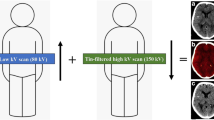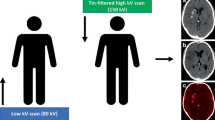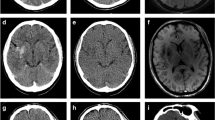Abstract
Objectives
To assess the feasibility of dual energy computed tomography (DE-CT) in intra-arterially treated acute ischaemic stroke patients to discriminate between contrast extravasation and intracerebral haemorrhage.
Methods
Thirty consecutive acute ischaemic stroke patients following intra-arterial treatment were examined with DE-CT. Simultaneous imaging at 80 kV and 140 kV was employed with calculation of mixed images. Virtual unenhanced non-contrast (VNC) images and iodine overlay maps (IOM) were calculated using a dedicated brain haemorrhage algorithm. Mixed images alone, as “conventional CT”, and DE-CT interpretations were evaluated and compared with follow-up CT.
Results
Eight patients were excluded owing to a lack of follow-up or loss of data. Mixed images showed intracerebral hyperdense areas in 19/22 patients. Both haemorrhage and residual contrast material were present in 1/22. IOM suggested contrast extravasation in 18/22 patients; in 16/18 patients this was confirmed at follow-up. The positive predictive value (PPV) of mixed imaging alone was 25 %, with a negative predictive value (NPV) of 91 % and accuracy of 63 %. The PPV for detection of haemorrhage with DE-CT was 100 %, with an NPV of 89 % and accuracy improved to 89 %.
Conclusions
Dual energy computed tomography improves accuracy and diagnostic confidence in early differentiation between intracranial haemorrhage and contrast medium extravasation in acute stroke patients following intra-arterial revascularisation.
Key Points
• Contrast material and haemorrhage have similar density on conventional 120-kV CT.
• Contrast material hinders interpretation of CT in stroke patients after recanalisation.
• Iodine and haemorrhage have different attenuation at lower kVs.
• Dual energy CT improves accuracy in early differentiation of haemorrhage and contrast extravasation.
• Early differentiation between iodine and haemorrhage helps to initiate therapy promptly.




Similar content being viewed by others
Abbreviations
- CTDIvol :
-
Computed tomography dose index
- DE-CT:
-
Dual energy computed tomography
- DLP:
-
Dose–length product
- IAR:
-
Intra-arterial recanalisation
- ICH:
-
Intracerebral haemorrhage
- IOM:
-
Iodine overlay maps
- VNC:
-
Virtual unenhanced non-contrast computed tomography
References
The National Institute of Neurological Disorders and Stroke rt-PA Stroke Study Group (1995) Tissue plasminogen activator for acute ischemic stroke. N Engl J Med 333:1581–1587
Rubiera M, Ribo M, Pagola J et al (2011) Bridging intravenous-intra-arterial rescue strategy increases recanalization and the likelihood of a good outcome in nonresponder intravenous tissue plasminogen activator-treated patients: a case-control study. Stroke 42:993–997
Mokin M, Kan P, Kass-Hout T et al (2012) Intracerebral hemorrhage secondary to intravenous and endovascular intraarterial revascularization therapies in acute ischemic stroke: an update on risk factors, predictors, and management. Neurosurg Focus 32:E2
Fiorelli M, Bastianello S, von Kummer R et al (1999) Hemorrhagic transformation within 36 hours of a cerebral infarct: relationships with early clinical deterioration and 3-month outcome in the European Cooperative Acute Stroke Study I (ECASS I) cohort. Stroke 30:2280–2284
Nakano S, Iseda T, Kawano H, Yoneyama T, Ikeda T, Wakisaka S (2001) Parenchymal hyperdensity on computed tomography after intra-arterial reperfusion therapy for acute middle cerebral artery occlusion: incidence and clinical significance. Stroke 32:2042–2048
Jang YM, Lee DH, Kim HS et al (2006) The fate of high-density lesions on the non-contrast CT obtained immediately after intra-arterial thrombolysis in ischemic stroke patients. Korean J Radiol 7:221–228
Kim JT, Heo SH, Cho BH et al (2012) Hyperdensity on non-contrast CT immediately after intra-arterial revascularization. J Neurol 259:936–943
Karcaaltincaba M, Aktas A (2011) Dual-energy CT revisited with multidetector CT: review of principles and clinical applications. Diagn Interv Radiol 17:181–194
Johnson TFC, Schönberg SO, Reissner MF (2010) Dual energy CT in clinical practice, 1st edn. Springer, Berlin
Postma AA, Hofman PA, Stadler AA, van Oostenbrugge RJ, Tijssen MP, Wildberger JE (2012) Dual-energy CT of the brain and intracranial vessels. AJR Am J Roentgenol 199:S26–S33
Ferda J, Novak M, Mirka H et al (2009) The assessment of intracranial bleeding with virtual unenhanced imaging by means of dual-energy CT angiography. Eur Radiol 19:2518–2522
Gupta R, Phan CM, Leidecker C et al (2010) Evaluation of dual-energy CT for differentiating intracerebral hemorrhage from iodinated contrast material staining. Radiology 257:205–211
Phan CM, Yoo AJ, Hirsch JA, Nogueira RG, Gupta R (2012) Differentiation of hemorrhage from iodinated contrast in different intracranial compartments using dual-energy head CT. AJNR Am J Neuroradiol 33:1088–1094
Parrilla G, Garcia-Villalba B, Espinosa de Rueda M et al (2012) Hemorrhage/contrast staining areas after mechanical intra-arterial thrombectomy in acute ischemic stroke: imaging findings and clinical significance. AJNR Am J Neuroradiol 33:1791–1796
Yoon W, Seo JJ, Kim JK, Cho KH, Park JG, Kang HK (2004) Contrast enhancement and contrast extravasation on computed tomography after intra-arterial thrombolysis in patients with acute ischemic stroke. Stroke 35:876–881
Lummel N, Schulte-Altedorneburg G, Bernau C et al (2013) Hyperattenuated intracerebral lesions after mechanical recanalization in acute stroke. AJNR. doi:10.3174/ajnr.A3656
Acknowledgements
E. Klotz is an employee of Siemens AG. J.E. Wildberger has received departmental research grants from Bracco, Bayer Healthcare, Philips Medical, GE Healthcare and Siemens Healthcare and interacted with Bayer Healthcare, Boston Scientific, GE Healthcare and Siemens Healthcare through a speaker’s bureau. A.A. Postma received a travel grant from Siemens Healthcare for a lecture in 2013.
Author information
Authors and Affiliations
Corresponding author
Rights and permissions
About this article
Cite this article
Tijssen, M.P.M., Hofman, P.A.M., Stadler, A.A.R. et al. The role of dual energy CT in differentiating between brain haemorrhage and contrast medium after mechanical revascularisation in acute ischaemic stroke. Eur Radiol 24, 834–840 (2014). https://doi.org/10.1007/s00330-013-3073-x
Received:
Revised:
Accepted:
Published:
Issue Date:
DOI: https://doi.org/10.1007/s00330-013-3073-x




